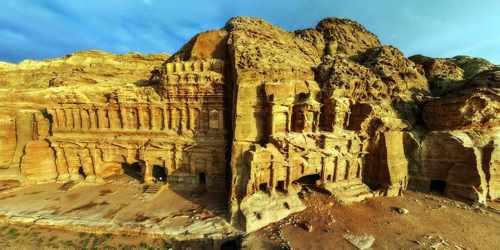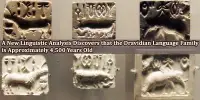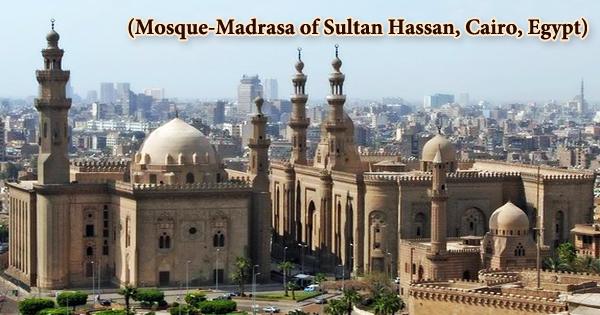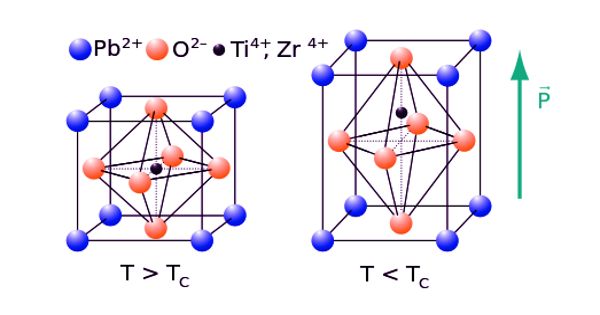“Petra” (Arabic: ٱلْبَتْرَاء, romanized: Al-Batrāʾ; Ancient Greek: Πέτρα, “Stone”), originally known to its inhabitants as Raqmu, ancient city, centre of an Arab kingdom in Hellenistic and Roman times, the ruins of which are in southwest Jordan. Petra lies around Jabal Al-Madbah in a basin surrounded by mountains which form the eastern flank of the Arabah valley that runs from the Dead Sea to the Gulf of Aqaba. The area around Petra has been inhabited as early as 7,000 BC, and the Nabataeans might have settled in what would become the capital city of their kingdom, as early as the 4th century BC. However, archaeological work has only discovered evidence of Nabataean presence dating back to the second century BC, by which time Petra had become their capital. The Nabataeans were nomadic Arabs who invested in Petra’s proximity to the trade routes by establishing it as a major regional trading hub.
Petra is located about 150 miles south of both Jerusalem and Amman, the capital of Jordan, and about midway between Damascus, Syria, and the Red Sea, making it ideally suited as a hub of commerce in the area. The site is considered significant by historians and archeologists alike because of its beautiful rock-cut architecture and innovative water management system, the latter of which made the region inhabitable, given that it is surrounded by desert and rugged, mountainous terrain.
It was “rediscovered” by Johann Ludwig Burckhardt in 1812 and today it is a major tourist attraction. Contrary to the plot of the Indiana Jones movie, Petra is not located in a “Canyon of the Crescent Moon” and it is not the location of the Holy Grail.

The city was built on a terrace, pierced from east to west by the Wadi Mūsā (the Valley of Moses) one of the places where, according to tradition, the Israelite leader Moses struck a rock and water gushed forth. The valley is enclosed by sandstone cliffs veined with shades of red and purple varying to pale yellow, and for this reason, Petra was called by the 19th-century English biblical scholar John William Burgon a “rose-red city half as old as Time.” The modern town of Wadi Mūsā, situated adjacent to the ancient city, chiefly serves the steady stream of tourists who continue to visit the site.
Petra was named a UNESCO World Heritage Site in 1985. UNESCO has described Petra as “one of the most precious cultural properties of man’s cultural heritage”.
In 2007, Al-Khazneh was voted one of the New7Wonders of the World. Petra is a symbol of Jordan, as well as Jordan’s most-visited tourist attraction. Tourist numbers peaked at 918,000 in 2010, but there followed a temporary slump during the political instability generated by the Arab Spring, which affected countries surrounding Jordan. Visitor numbers subsequently increased and reached a record-breaking 1.1 million tourists in 2019, marking the first time that the figure rose above the 1 million mark.
The Greek name Petra (“Rock”) probably replaced the biblical name Sela. Remains from the Paleolithic and Neolithic periods have been discovered at Petra, and Edomites are known to have occupied the area about 1200 BCE. Centuries later the Nabataeans, an Arab tribe, occupied it and made it the capital of their kingdom. In 312 BCE the region was attacked by Seleucid forces, who failed to seize the city. Under Nabataean rule, Petra prospered as a center of the spice trade that involved such disparate realms as China, Egypt, Greece, and India, and the city’s population swelled to between 10,000 and 30,000. Access to the city is through a 1.2-kilometer-long (0.75 mi) gorge called the Siq, which leads directly to the Khazneh. Famous for its rock-cut architecture and water conduit system, Petra is also called the ‘Rose City’ because of the color of the stone from which it is carved.
Pliny the Elder and other writers identify Petra as the capital of the Nabataean Kingdom and the center of their caravan trade. Enclosed by towering rocks and watered by a perennial stream, Petra not only possessed the advantages of a fortress, but controlled the main commercial routes which passed through it to Gaza in the west, to Bosra and Damascus in the north, to Aqaba and Leuce Come on the Red Sea, and across the desert to the Persian Gulf.
When the Nabataeans were defeated by the Romans in 106 CE, Petra became part of the Roman province of Arabia but continued to flourish until changing trade routes caused its gradual commercial decline. After an earthquake (not the first) damaged the city in 551, significant habitation seems to have ceased. The Islamic invasion occurred in the 7th century, and a Crusader outpost is evidence of activity there in the 12th century. After the Crusades the city was unknown to the Western world until it was rediscovered by the Swiss traveler Johann Ludwig Burckhardt in 1812.
Analysis of housing remains at ez-Zantur, within Petra, suggests that people were building houses out of stone by 2,100 years ago, heralding a period of urbanization. This process would see people abandon their tents for more permanent stone dwellings, in some instances carving them into the cliffs. In time freestanding homes for the elite would be created containing columns and multiple rooms.
Excavations have demonstrated that it was the ability of the Nabataeans to control the water supply that led to the rise of the desert city, creating an artificial oasis. The area is visited by flash floods, but archaeological evidence shows that the Nabataeans controlled these floods by the use of dams, cisterns and water conduits. These innovations stored water for prolonged periods of drought and enabled the city to prosper from its sale.
Petra’s main street, referred to today as the colonnaded street, would be built on the south side of the Wadi Musa (a riverbed that sometimes has water). Walls would eventually be built on the north and south side of this wadi which, combined which Petra’s cliffs, made the city very hard to invade.

(Petra’s temples, tombs, theaters, and other buildings are scattered over 400 square miles)
Petra contains numerous tombs, most of them built at the edge of the city, beyond the main street. Some were simple, containing multiple burials in an unadorned rock chamber, while others were more spectacular.
The best-known tomb at Petra is called the “Khazneh,” which is Arabic for the “Treasury.” It is called this because at one time local people believed it contained hidden treasure. Today, archaeologists regard it as a two-story-high tomb, albeit a masterful one. Its facade measures 82 feet (25 meters) wide and 128 feet (39 meters) high.
After the eighth century, when Petra was largely abandoned as a trading center, its stone structures were used for shelter by nomadic shepherds for several centuries. Then, in 1812, the unique ruins of Petra were “discovered” by Swiss explorer Johann Ludwig Burckhardt. He described the ruins of the once-great city in chronicles of his travels. With the western world now aware of their existence, they soon attracted the interest of architects and scholars, among others. Starting in 1929, British archaeologists Agnes Conway and George Horsfield, as well as scholars Tawfiq Canaan and Ditlef Nielsen, launched a formal project to excavate and survey Petra.

(The narrow passage (Siq) that leads to Petra)
Excavations from 1958 on behalf of the British School of Archaeology in Jerusalem and, later, the American Center of Oriental Research added greatly to knowledge of Petra. The ruins are usually approached from the east by a narrow gorge known as the Siq (Wadi Al-Sīq). Among the first sites viewed from the Siq is the Khaznah (“Treasury”), which is actually a large tomb. Al-Dayr (“the Monastery”) is one of Petra’s best-known rock-cut monuments; it is an unfinished tomb facade that during Byzantine times was used as a church. Many of the tombs of Petra have elaborate facades and are now used as dwellings. The High Place of Sacrifice, a cultic altar dating from biblical times, is a well-preserved site. To support the ancient city’s large population, its inhabitants maintained an extensive hydrological system, including dams, cisterns, rock-carved water channels, and ceramic pipes. Excavations begun in 1993 revealed several more temples and monuments that provide insight into the political, social, and religious traditions of the ancient city. The ruins are vulnerable to floods and other natural phenomena, and increased tourist traffic has also damaged the monuments. In 1985 Petra was designated a UNESCO World Heritage site.
In Petra, there is a semi-arid climate. Most rain falls in the winter. The Köppen-Geiger climate classification is BSk. The average annual temperature in Petra is 15.5 °C (59.9 °F). About 193 mm (7.60 in) of precipitation falls annually. Petra’s ancient inhabitants maintained a rich spiritual life. Three temples located near the main street are believed to date to the city’s zenith, about 2,000 years ago.
When Petra was named a UNESCO World Heritage Site in 1985, Petra Bedouin tribespeople who had made homes for themselves within the city’s remaining ruins were forcibly relocated by the Jordanian government.
In the early 2000s, the site (Petra) was named one of the “Seven New Wonders of the World,” leading to a spike in tourism. Since then, efforts have been made to protect the ruins of Petra from heavy tourism, as well as damage from floods, rain, and other environmental factors.
In 2016, archaeologists using satellite imagery and drones discovered a very large, previously unknown monumental structure whose beginnings were tentatively dated to about 150 BCE, the time when the Nabataeans initiated their public building program. It is located outside the main area of the city, at the foot of Jabal an-Nmayr and about 0.5 mi (0.80 km) south of the city center, but is facing east, not towards the city, and has no visible relationship to it. The structure consists of a huge, 184 by 161 ft (56 by 49 m) platform, with a truly monumental staircase all along its eastern side. The large platform enclosed a slightly smaller one, topped with a comparatively small building, 28 by 28 ft (8.5 by 8.5 m), which was facing east toward the staircase. The structure, second in size only to the Monastery complex, probably had a ceremonial function of which not even a speculative explanation has yet been offered by the researchers.
Under Jordanian National law, responsibility for the protection of Antiquities sites lies with the Department of Antiquities, a separate entity under the Ministry for Tourism and Antiquities. The property is a protected area within the Petra Archaeological Park managed by the Ministry of Tourism and Antiquities. However, responsibility for the overall planning and implementation of infrastructure projects at the site rests largely with the Petra Regional Authority (PRA) originally the Petra Regional Planning Council (PRPC) but now expanded to cover the social and economic wellbeing of the communities in the locality.
According to Arab tradition, Petra is the spot where Musa (Moses) struck a rock with his staff and water came forth, and where Moses’ brother, Harun (Aaron), is buried, at Mount Hor, known today as Jabal Haroun or Mount Aaron. The Wadi Musa or “Wadi of Moses” is the Arab name for the narrow valley at the head of which Petra is sited. A mountaintop shrine of Moses’ sister Miriam was still shown to pilgrims at the time of Jerome in the 4th century, but its location has not been identified since.
Information Sources:
















